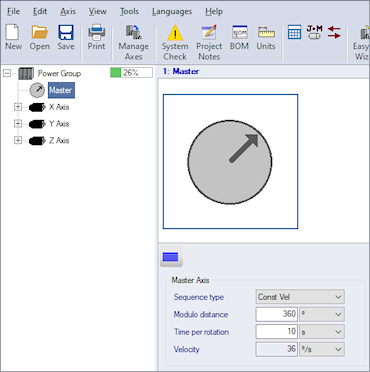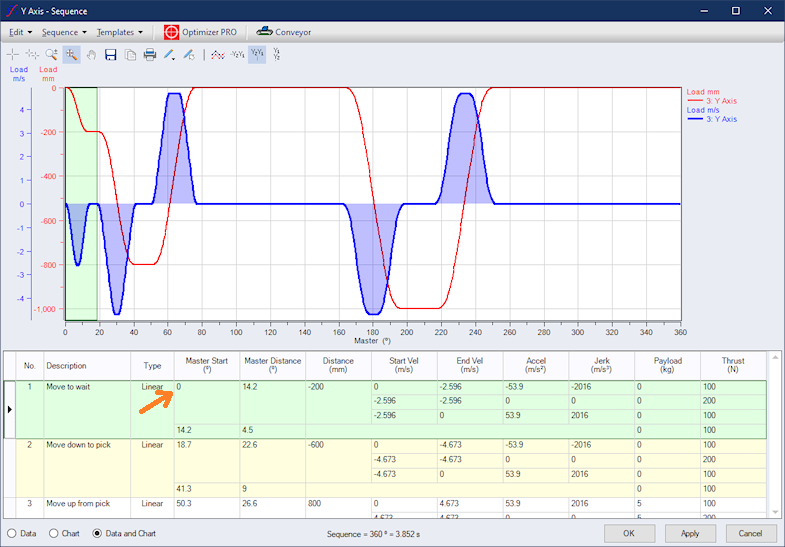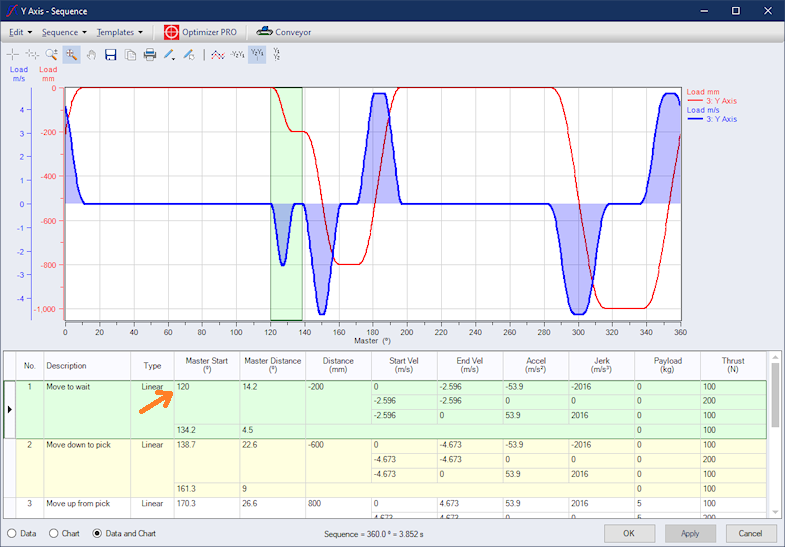
Master-Follower mode allows users to define the motion sequence
of each Follower axis with respect to its Master axis position.
Once defined, users can change the Cycle Time of the Power
Group by simply changing the speed of the Master axis.
The Master-Follower "coupling" is very different to classical
"Time" sequences where each axis is defined by its own time-based
move sequence. In Master-Follower mode, only the Master axis has a
time reference by its speed value. The Follower axis moves are
related to the Master, so the sequence is to be defined dependent
on the Master position. Hence Master-Follower calculation and
classical Time calculation exclude each other. By definition, all
positions, Master and Follower, are at the load side of the
mechanism.
The Master axis is always the first slot in its Power Group. The
Master Axis is a Virtual Rotary axis, which means there are no
mechanics, just a Sequence.
| 'Master-Follower' is available in the PRO
version. |
The Master Position is Modulo from 0° to x°, where x is most
often 360°, but might be different in some cases. The Master
Sequence can be a "Constant Velocity" or a "Variable" Sequence.
When “Constant Velocity”, which is the most common operating mode,
the Master Sequence is limited to a single positive constant
velocity segment.
When in Max-Stop mode, the Master is switched to a "Variable"
Sequence. In this mode, a fully programmable Master Sequence can be
defined, allowing for ramping the Master Velocity to zero at any
point in the Sequence, such that all axes in the Power Group are
brought to a stop according to their Master-Follower sequences.
For more advanced users interested in specialized optimization,
the Master can operate as a "Variable" Sequence in normal mode.
When combined with the Optimizer,
tremendous improvements in performance gains can be achieved.
The Master Velocity is always >0, except in Max-Stop mode
where the Master Velocity >=0.
|
An interesting and perhaps unique feature is the ability to
convert the Sequence Type to/from Time and Master-Follower modes.
Even Follower S-Curved/Jerk profiles, Segments and Moves, can be
converted with a "Constant Velocity" Master.
|

|
Each Follower Sequence is a function of the Master Position.
Effectively, the Time component is replaced by the Master Position.
"XBase" is the specific term, where in a Time based Sequence, XBase
is Time, and in a Master-Follower Sequence, XBase is the Master
Position. When the Master is a Constant Velocity Sequence, the
transition from Time to Position is effectively a ratio or scale
factor. By default, the Follower Sequence chart typically has the
Master Position on the X scale of the chart, as its "XBase", and
the "Start Time" and "Duration" columns are the "Master Start
Position" and "Master Duration" columns respectively. However, in
Master-Follower mode, the chart X scale can be set to Time if
desired.
The Follower Sequence must be defined for its Master's full
Modulo Distance, otherwise, a critical alarm message appears in
System Check.
By default, each Follower Sequence starts at Master 0°. However,
the "Follower Master Start Position" allows each Follower axis to
start at a point other than the Master start of 0°. The Follower
Master Start Position must be >=0. When the Follower Master
Start Position > 0, and the Follower Sequence is defined for
the full Master Modulo distance, in this case 360°, then the
end of the Follower sequence wraps around to the start of the
sequence up to the Master Follower Start Position.
Follower Master Start = 0°

Follower Master Start = 120°

Related topics

 Master
Sequence
Master
Sequence
 Switching from
"Time" to "Master-Follower" and Vice Versa
Switching from
"Time" to "Master-Follower" and Vice Versa
 Follower
Sequence
Follower
Sequence
 Follower Master
Start Position
Follower Master
Start Position